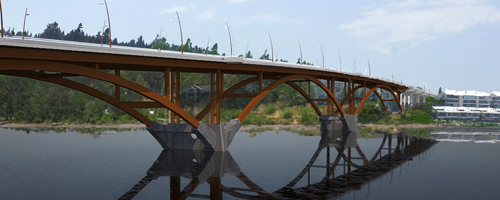The big one will hit Portland, earthquake experts say, in only a matter of time. So, for the next two and a half years, Portland’s engineers, a group that includes experts and students within the Portland State community, will work to ensure that the Sellwood Bridge can withstand this natural disaster.
New Sellwood Bridge drives students’ learning
[portfolio_slideshow id=46046]
The big one will hit Portland, earthquake experts say, in only a matter of time.
So, for the next two and a half years, Portland’s engineers, a group that includes experts and students within the Portland State community, will work to ensure that the Sellwood Bridge can withstand this natural disaster.
Oregon is located in the middle of a subduction zone, where the friction caused by the movement between two overlapping tectonic plates can cause hard-hitting earthquakes.
Portland State civil and environmental engineers say a subduction zone earthquake is bound to wreak havoc on Portland’s infrastructure and crossings.
“There is no doubt that Oregon will be hit hard,” said Peter Dusicka, an assistant professor of civil and environmental engineering who conducts tests of infrastructure durability at the iSTAR Laboratory in the Science Research and Teaching Center at PSU.
The foundations under the current Sellwood Bridge would be destabilized by such a quake and could collapse under its jolts. At the time of the Sellwood Bridge’s original construction, in 1925, the threat of a 9.0 magnitude earthquake was not a factor in its design, Dusicka said.
“Any bridge form can be designed to withstand an earthquake,” he said. “We’ve learned enough from past earthquakes to know our infrastructure was deficient.”
The new bridge
Evan Kristof, a structural engineering instructor at PSU, was part of the team at T.Y. Lin International Group, an engineering firm, that designed the arch span of the new Sellwood Bridge. He continues to advise those implementing his designs on the construction site. Kristof said that the arch type of the new bridge, which includes a wide pedestrian and bike path, was the preferred alternative of a Multnomah County study that evaluated potential bridge designs for safety, cost, aesthetics and construction time.
A factor that contributes to the lengthy construction of this bridge is the fabrication of structural steel for the main crossing. The bridge’s structures are formed by melting steel down and turning them into long plates that are then used to build the components, a process that takes more than a year. Then, the components will be transported down river to the Sellwood Bridge.
Kristof noted that the new bridge will be a vast improvement to the quality of life in Sellwood. Walking or biking across the old Sellwood Bridge, he said, could be a downright scary experience.
According to the Sellwood Bridge project’s website, during the initial construction of the Sellwood Bridge in 1925, concern for aesthetics and safety was undervalued, and the project was sped up out of a growing need for a way to connect the East and West banks. At the time, the Spokane Ferry was the only way for commuters to cross that point of the river.
When the time came to build the bridge, however, cost was prioritized over safety and parts of the old Burnside Bridge, which was then being replaced, were recycled for the 1925 Sellwood Bridge.
The original bridge was eventually constructed for just over $500,000, while the new bridge is being constructed for more than $300 million.
“We expect [the new bridge] to have a high safety rating,” said Mike Pullen, head of public relations for the project.
During the planning phases for this bridge, Pullen said that some members of the public had suggested that the new bridge once again recycle parts of the old to cut down on costs. However, this strategy would have been too risky and isn’t a true money-saver, Pullen said.
Planning officials also ran into difficulties when selecting a location for the bridge. Pullen said that the county had to buy six private homes and two businesses to obtain enough land for the new bridge, which will be twice as wide as the original bridge.
During this year’s construction, the biggest highlight of the project, Pullen said, has been the move of the actual Sellwood Bridge to make room for the detour (or “Shoofly”) bridge. In this feat of engineering, 3,400 tons of the old Sellwood Bridge truss span—a fifth of a mile long—was moved onto temporary supports so that traffic between the banks could continue during construction.
Freshman civil and environmental engineering student Natalie Lyons was fascinated by this stage in the construction process. Her civil engineering class (CEE 100) went down to the bridge construction site with instructors
Robert Bertini and Kristof.
“[It’s] interesting that when the old bridge was built, they didn’t think about making it earthquake-safe because they didn’t know that we’re on a fault line,” Lyons said with a laugh. “[Now] they moved it over to steel structures that are much safer than the bridge was before, even though [those structures] are temporary.”
Lyons also said that she was intrigued by some of the environmentally conscious planning that was required for the construction of the bridge: The bridge’s “self-weathered steel” will not need to be painted, and in-water work on the bridge will be postponed until after fish migration season.
Bertini felt that it was important to give young engineering students a practical application of what they’re learning in the classroom.
“They were fascinated [with] how you’d go about designing and implementing a project like that,” he said. “I try to keep the students interested in our field and get them out into the real world at this early stage in the curriculum, so they can make the connection between the real world and the classroom.
“They can know that they’ll have their chance in a few years,” Bertini said.
The iSTAR lab
In PSU’s iSTAR lab, civil and environmental engineering students cluster around imposing columns and collect data. Dusicka said that the students are preparing to test the durability of these “vintage columns” from the 1960s through 1980s that were characteristic of Oregon bridges.
Doctoral student Selamawit Mehary initially came to this project when she authored a report with Dusicka and the Oregon Department of Transportation in 2009. The report addressed the seismic vulnerability of Western Oregon’s highway bridges and found that the majority of highway bridges would not withstand significant earthquake damage.
Mehary said that iSTAR’s test on the vintage columns in a few weeks will begin to examine how retrofitting these structures will play into findings from that ODOT study.
First, the iSTAR lab will test the original columns to see how they will withstand conditions that resemble those of a damaging earthquake. Then, the lab will see how columns will withstand the same conditions once retrofitted, Mehary said.
“We’re in a fairly unique time in Oregon right now,” Dusicka said of the seismic vulnerability of the new Sellwood Bridge’s construction and the need for a new [Interstate-5] bridge across the Columbia River.
“The I-5 [crossing] is probably one of the most seismically vulnerable ones around,” he said.
And, column by column, detour by detour, Portland’s infrastructure is inching toward preparation for the inevitable.






